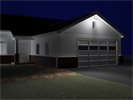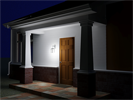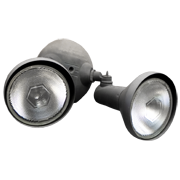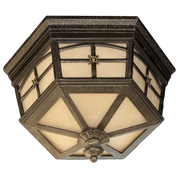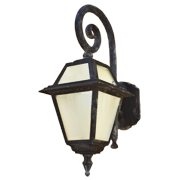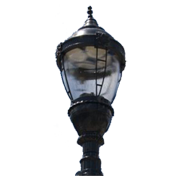
Exterior Fixtures
Exterior fixtures include floodlights, post-top lights, and porch lights. They illuminate buildings, pathways, and landscapes and provide lighting for safety, security, and decoration.
Floodlights provide light over a large area. Some floodlights protect the bulbs and alter the light distribution with a glass or plastic diffuser. The simplest installation is to mount the floodlight on a pole, eave, or side of a building. Increasing the mounting height increases the area that will be lit, but lowers the illuminance. Higher mounting also makes replacing bulbs more difficult.
Accent lighting and small area lighting is used to define or emphasize a specific area or objects of special interest, such as entries and porches, or trees and foliage. To light objects such as a sculpture or fountain, use spot lighting with fixtures designed for narrow beam distribution. Shield the bulbs from view and conceal them with shrubbery if mounted on the ground. To illuminate a small area with ambient light and provide a decorative element, consider a post-top light with shielding to prevent uplight.
Porch lights and post-top lights provide light for a small area such as a porch or entry to allow for safe passage, identification of visitors, and tasks such as finding door keys.
Exterior lighting requires special consideration because of visibility to neighbors and the public. To avoid light pollution such as glare, choose fixtures in which the bulb is properly shielded and aim the light only on the desired areas, typically downward. To limit light trespass, prevent light from falling outside the boundary of the property by reducing overall light levels, aiming fixtures appropriately, and using trees, fences, or other shielding. Exterior lighting should never be aimed directly at windows, nor outside of the property boundaries.
Consider using controls to limit the amount of time that exterior fixtures are on. Timers control exterior lighting on a regular schedule. Use motion sensors to illuminate areas only when people approach. Dusk-to-dawn sensors, also known as photosensors, switch the fixture off automatically when daylight increases above a specified level.
Cautions
- Exterior fixtures must be weatherproof, and the housings should be Underwriters Laboratories (UL) listed for either "wet location" (fully exposed to weather) or for "damp location" (sheltered areas such as enclosed porches.
- Fluorescent bulbs may not start well in very cold weather and may take some time to come up to full light output.
- Avoid light trespass: light that strays onto a neighbor's property may be annoying and may conflict with municipal legislation.
- Shadows can be an advantage as well as a disadvantage: they can create dramatic effects, but they provide areas where intruders may hide or pass undetected.
Example Patterns
